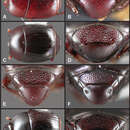Description
provided by Zookeys
Length: 1.97–2.00 mm, width: 1.68–1.78 mm; body rufopiceous, elongate oval; subdepressed; frons weakly depressed at middle, with fine, sparse ground punctation; frontal stria divergent between eyes, curving mediad, weakly sinuate over antennal bases, fine, complete, and arcuate across front; epistoma shallowly emarginate apically; labrum about twice as wide as long, truncate apically; pronotum lacking prescutellar impression, with fine, rather conspicuous ground punctation, with ~15 coarse lateral punctures; marginal stria broadly interrupted behind head; lateral submarginal stria complete along side, curving inward, meeting or nearly meeting anterior marginal stria at weak postocular angle, anterior marginal stria may be very weakly recurved posterad if free; median pronotal gland openings about half pronotal length behind anterior margin; elytron with two complete epipleural striae, outer subhumeral stria complete, sinuate at middle, inner subhumeral stria present in apical half, dorsal striae 1-3 complete, striae 4-5 present in apical half, sutural stria present in apical three-fourths; elytra with weak strioles between apices of striae 1 and 2; prosternal keel outwardly produced at base, carinal striae complete, rather narrowly separated, united anteriorly and posteriorly; prosternal lobe narrowly rounded, marginal stria complete, well impressed; anterior margin of mesoventrite shallowly emarginate, with complete marginal stria; mesometaventral stria weakly arched forward at middle, reaching basal third of mesoventrite, continued by lateral metaventral stria posterolaterad toward middle of metacoxa; 1st abdominal ventrite with two complete lateral striae; propygidium with moderately dense ground punctation mostly obscured by uniformly dense secondary punctures; pygidium with dense ground punctation with numerous small secondary punctures interspersed; marginal pygidial sulcus deep, complete, not ending in basal foveae. Male genitalia: segments 8-10 very similar to those of Operclipygus subdepressus (see Figs 68A–C), except S8 with sides weakly convergent to apex, apical guides undeveloped at base, only slightly widened in apical half to rounded apices; S9 [of only available male broken across stem near apex] with stem broader, with rounded apical emargination; tegmen (Fig. 68F) short and broad, widest about one-third from apex, with extremely large and projecting medioventral tooth; median lobe with wide gonopore, long proximal apodemes, showing weak differentiation; basal piece about one-third tegmen length.
- license
- cc-by-3.0
- copyright
- Michael S. Caterino, Alexey K. Tishechkin
- bibliographic citation
- Caterino M, Tishechkin A (2013) A systematic revision of Operclipygus Marseul (Coleoptera, Histeridae, Exosternini) ZooKeys 271: 1–401
- author
- Michael S. Caterino
- author
- Alexey K. Tishechkin

